
There have been lots of movies with giant spiders in them. One of the things that makes them look so creepy is having so many eyes. But is that just something from the imagination of Hollywood?
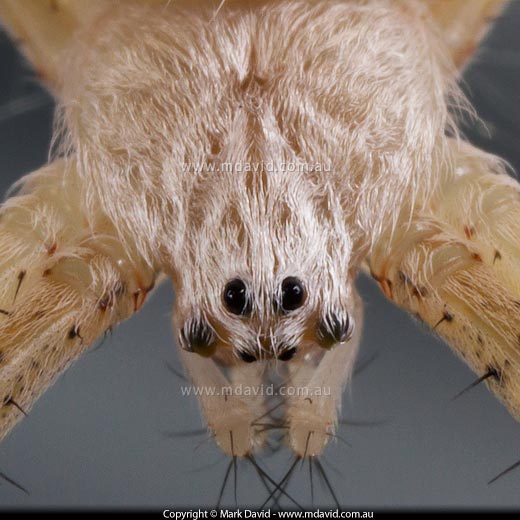
This young St Andrew’s Cross Spider (Argiope species) doesn’t need great eyesight. Its orb web does the main job at catching prey
Most spiders, but definitely not all spiders, have eight eyes, and the way those eyes are arranged can often help scientists work out what kind of spider it is. Of course, that’s assuming they’re prepared to get close enough.
Spiders usually have some eyes on top of their head* and some more in front. With so many eyes, it’s a bit surprising that they usually don’t have good eyesight. Instead, they probably just see light and dark shapes moving around. When they’re hunting they make up for that bad eyesight with an excellent ability to sense vibration and taste.
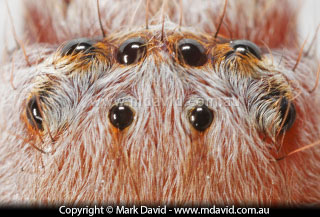
Let’s start by talking about a spider which lots of us are familiar with.
This close-up picture of a Huntsman spider shows two rows of eyes, with four eyes in
each row.
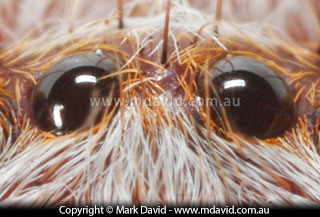
When we move in a bit closer we can see that the surfaces of those eyes appear to be shiny and smooth. These kinds of eyes are called simple eyes because each eye contains just one lens.
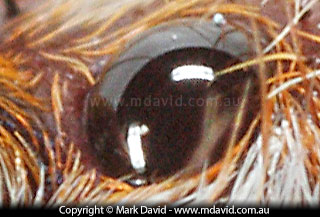
Here’s one of those eyes shown at even greater magnification. I’m grateful to the Huntsman for sitting so still for me while I took this photo.
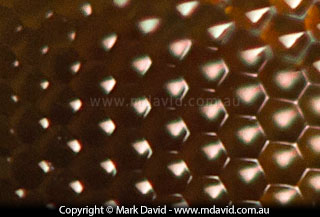
Compare the smooth surface of that simple eye in the photos above with the surface of a compound eye, shown in the extreme closeup in this next image. This picture shows just a very tiny part of the surface of a Dragonfly’s eye magnified so much that you can see that it’s covered with tiny facets. Each one of those little facets is another lens. Spiders do not have these types of eyes.
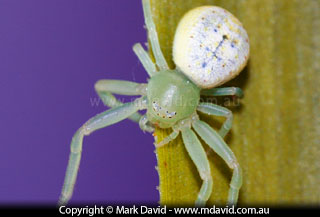
That Huntsman spider had a lot of hair, which made it a bit tricky counting its eyes. So it would be nice to find a spider that wasn’t so hairy. This flower spider (Diaea variabilis) will do. So let’s move in a lot closer.
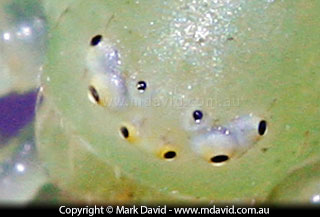
This should do it. At this magnification it’s easy to count eight eyes.
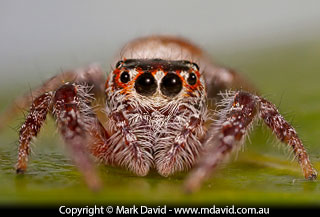
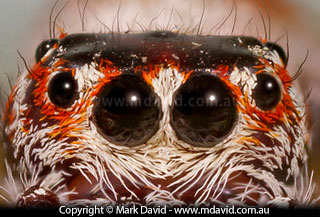
I was talking before about how most spiders, despite having up to eight eyes, usually have poor eyesight. One exception to that bad-eyesight rule is the group of jumping spiders, which see really well. They have very big eyes on the front of their head*. The pictures of a typical jumping spider shown here makes this point pretty clear.
When you look at that pictures you’ll notice two things:
- It has a row of big black eyes
- It’s watching me take its photo
Those two things are connected. Jumping spiders see a lot of stuff with those big eyes. They use them to investigate whatever they see moving. That can make them difficult to photograph because they keep jumping onto the camera lens.
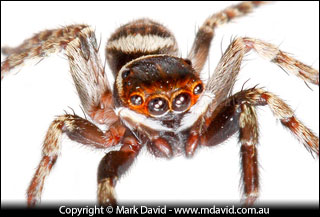
Just to prove that one wasn’t unusual, here’s another type of jumping spider. You can see those big eyes along the front again. From this angle you can see that there are more than just those big four big eyes.
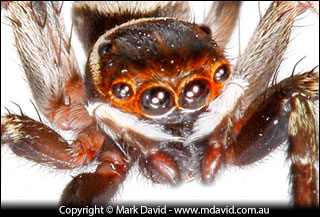
Moving in closer it’s now possible to see that, once again, there are eight eyes. Well, it’s possible, but not so easy …

… so I made it easy. In this picture I’ve traced the outlines of that spider and coloured the eyes in red. Now you can see more clearly what I was talking about.

Here’s one of my favourite spiders. It’s called Deinopis and I think they’re cool because their faces look almost human! In fact, that face has earned these spiders the name of Ogre-faced Spiders. But does it have only two eyes like a human?

Nope! It turns out that these guys have eight eyes too.
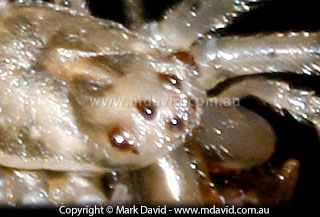
So then, what’s the full story? Exactly how many eyes do spiders have?
When you start looking around you find that some have six eyes. And there are other kinds of spiders with four, two or even no eyes!
But most spiders have eight eyes.
*I talked about eyes on the front of spiders’ heads. Well, maybe I shouldn’t have said that. Unlike insects, which have a head, a thorax (the bit in the middle) and abdomen (the bit at the end), a spider’s head and thorax are combined into one big section called the ‘cephalothorax’. So I should have talked about those eyes being on the front of its cephalothorax instead. Now don’t you just love that kind of accuracy.






